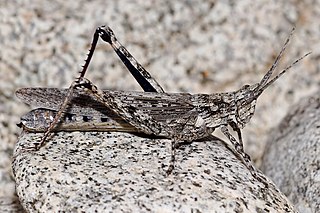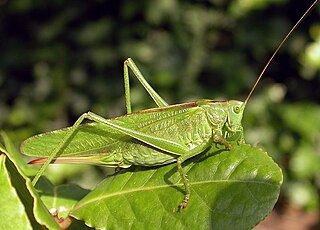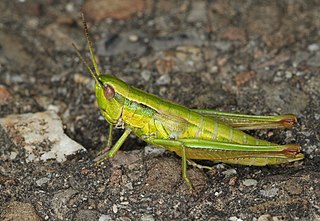
Acrididae are the predominant family of grasshoppers, comprising some 10,000 of the 11,000 species of the entire suborder Caelifera. The Acrididae are best known because all locusts are of the Acrididae. The subfamily Oedipodinae is sometimes classified as a distinct family Oedipodidae in the superfamily Acridoidea. Acrididae grasshoppers are characterized by relatively short and stout antennae, and tympana on the side of the first abdominal segment.

Bandwings, or band-winged grasshoppers, are the subfamily Oedipodinae of grasshoppers classified under the family Acrididae. They have a worldwide distribution and were originally elevated to full family status as the Oedipodidae. Many species primarily inhabit xeric weedy fields, and some are considered to be important locusts:

Xysticus is a genus of ground crab spiders described by C. L. Koch in 1835, belonging to the order Araneae, family Thomisidae. The genus name is derived from the Ancient Greek root xyst, meaning "scraped, scraper".

Ranatra is a genus of slender predatory insects of the family Nepidae, known as water scorpions or water stick-insects. There are around 100 Ranatra species found in freshwater habitats around the world, both in warm and temperate regions, with the highest diversity in South America and Asia. Fewer are found elsewhere, but include several African, some in North America, three from Australia and three from the Palearctic, notably the relatively well-known European R. linearis. Since Ranatra belongs to the family Nepidae which in turn belongs to the order Hemiptera, ranatrids are considered "true bugs".

The Tettigoniinae are a subfamily of bush crickets or katydids, which contains hundreds of species in about twelve tribes.

Coreinae is a subfamily in the hemipteran family Coreidae. They have been shown to be paraphyletic with respect to Meropachyinae.

Rhynocoris is a genus of assassin bug, family (Reduviidae), in the subfamily Harpactorinae. Species are recorded from Asia, mainland Europe, Africa and North America.

Gomphocerinae, sometimes called "slant-faced grasshoppers", are a subfamily of grasshoppers found on every continent but Antarctica and Australia.

Nepa is a genus belonging to the family Nepidae, known as water scorpions. There are six species found in freshwater habitats in the Northern Hemisphere.

Tytthus is a genus of insects in family Miridae, the plant bugs. They are carnivorous, feeding upon the eggs of various planthoppers in the family Delphacidae, and thus are important in the biological control of pests. The genus is distributed throughout the Holarctic of the Northern Hemisphere, but species are also found in the tropics, in China, South America, Australia, and the Indo-Pacific.

Plagiognathus is a genus of jumping tree bugs in the family Miridae. There are more than 120 described species in Plagiognathus.
Graptocorixa is a genus of water boatmen in the family Corixidae. There are about six described species in Graptocorixa.

Achilidae is a family of planthoppers, sometimes called "achilids" in the order Hemiptera. There are at least 520 described species in Achilidae.
Notonecta unifasciata is a species of backswimmer in the family Notonectidae. It is found in Central America, North America, and South America.

Hallodapini is a tribe of plant bugs in the family Miridae. There are more than 50 genera in Hallodapini.

Hesperocorixa is a genus of water boatmen in the family Corixidae. There are more than 20 described species in Hesperocorixa.

Proutista is a small genus of planthoppers from the family Derbidae, tribe Zoraidini, with 10 species, as of 2024. The type species, Proutista moesta is widely distributed and often very common, its distribution ranging from Tanzania in Africa, over some Indian Ocean islands and southern parts of western Asia to far eastern Asia and parts of the western Pacific. Seven of the remaining species are also found in tropical parts of Asia and only two additional species have been recorded from Africa, where Proutista fritillaris is the most common one. The species of Proutista are characterized by a combination of different features, mainly the shape and venation of the forewings, the size of the hind wings and the structure of the head and the antennae. On the forewings the media vein has 6 branches, none of them branching further into sub branches. The hind wings are about half as long as the forewings and have a rounded tip. The head has a narrow face (frons) and the antennae are rather short, much shorter than the face.



































